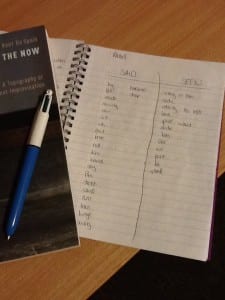So this week, it was decided it was time to put down the bean bags and focus on our body. The class required a lot more letting go but at the same time a lot more concentration. We began by gradually moving around the space at a slow speed which allowed time for everyone to focus in on themselves. As the speed of the movement increased, I found myself losing focus on what my body was actually doing, I was focusing on constantly moving and ended up using a lot of repetitive movement. Due to this, I was then debating with myself as to whether that was true improvisation, as there was no thought process behind the movement, I was following what my body wanted to do. It did feel myself let go as I threw my body around the space a bit more, yet on reflection I felt that the movement was perhaps ugly and would be useless if I were to actually choreograph something from it.
One element of the class I felt I particularly benefitted from was the ‘pause, imagine, move’ task. By taking the time to pause and think about how to move from one position to another and then imagining myself performing that move, it allowed me to explore with all the possible ways of moving. It enabled me to focus on particular parts of my body and use techniques that I perhaps don’t use a lot, such as spiralling in the waist rather swinging my arm on a wheel plane. This contrasted to earlier in the class when improvising at a fast speed with no time to think, as then I felt my limbs were moving without control and all at the same time, however in this task I was allowed a lot more control.

When it came to partner work, there were aspects I found enjoyable and useful but there were aspects I also found challenging. I enjoyed improvising whilst my partner watched and wrote down what she saw because I was dictating the movements and I was making my own choices. However, when it switched to my partner then reading out what she wrote and me following what she said, it was more difficult as it put me more on the spot even though I had just performed those same movements. Then when it came to us both improvising, both dictating and yet following each other at the same time, I found that this was the most challenging as it was hard to follow your own decisions whilst listening to your partner’s. This linked to last weeks class, demonstrating further how other people’s decisions affect your own and you have to react to it. However it was interesting to see that, although we both had separate agendas and our movements were slightly different, there was a connection between the two dancers, which I am keen to explore further when choreographing in the future.
The decisions we make whilst improvising also link to the tracking technique. When reading about this technique in the readings I was very confused by the difference between conscious and unconscious awareness. I took from the reading that if you are conscious that you are tracking, you are not truly tracking your improvisation, you are in fact dancing. Yet if you are unconsciously tracking, you are truly improvising. I’m still not sure as to whether this is correct or not but I guess it depends on the dancer. It wasn’t until I read Nancy Stark Smith’s input on tracking that I began to comprehend more. She uses a technique called ‘telescoping awareness’, describing that ‘It’s not about being aware of everything all the time, but flickering in and out’ (De Spain, 2014, 51). This type of awareness taught me that you can be completely focused on one sensation but then you can zoom out and focus on the larger picture, or switch to a different sensation. For example, there are many different purposes for tracking, such as where you are in the music, or on stage or where you are compared to others on stage, and so by using the ‘telescoping awareness’ technique, it enables you to flicker between these elements, rather than trying to focus on them all, all at once. I also embraced her idea of the ‘idiot button’ which can come in handy when you become stuck in your movement or ‘you are just too aware of too many things and it gets almost too turgid or something’ (De Spain, 2014, 51), tracing back to what I said last week about it being okay to cross everything out and start again by reminding yourself of the basics.
I know its only the second week, but I’m already feeling pretty confident in myself and my learning, there is still plenty of time for things to go wrong, and no doubt they will. But as long as each week I settle in to class thinking of it as the next level up in my learning, I know my confidence will only grow.
De Spain, K. (2014) Landscape of the Now: A Topography of Movement Improvisation. New York: Oxford University Press.